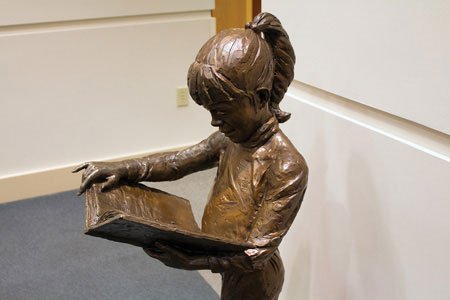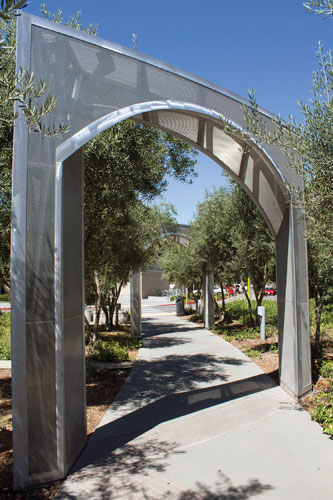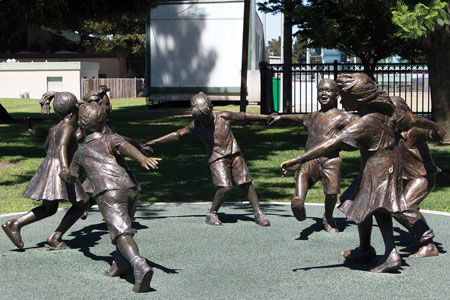
While there’s plenty of outdoor art pieces throughout the City of Santa Clara, some of the most-seen works are at the city’s public library on Homestead Road.
Within the 80,000 square foot, two story library, and surrounding outdoor area, are pieces by seven artists: Barbara Grygutis, David Smith, Gary Price, Irene Pijoan, Jeremy Lutes, Lynne-Rachel Altman and Randall Shiroma.
Outside of the museum, on the Homestead side, is Grygutis’ “The Illuminated Page,” a set of stainless steel and cast aluminum archways welcoming visitors. Within each arch there are floating books, disks, computers and plants made out of aluminum, all of which symbolize the merging nature with the mind. “The soft light from within the arbor structures creates a magical sense of space,” says Grygutis of the piece, which is lit at night. “These arched forms are inspired by the concept of illuminated manuscripts. The illuminated page is a central theme.”

Smith contributes 28 glass panels located throughout the library in “The Janus Windows.” The panels, which combine letters and binary code, represent the written word and digital transference of information. “The panels engage the viewer on an intellectual level while creating subtle patterns of translucence and opacity that change with the quality of light,” says Smith. ‘Windows have traditionally been associated with knowledge, light, analysis and inquiry. The ‘windows’ I have created for the library reflect the purpose of a community library while subtly energizing the open space.”
With pieces both inside and outside of the library, Price’s bronze sculptures are some of the most recognizable of the bunch. In “Circle of Peace,” the sculpture of children holding hands in a circle outside of the library, Price depicts “children from all walks of life, whose clasped hands represent the interaction that engenders a humanity full of compassion and respect. Inside, Price’s “Bookworm I” and “Bookworm 2,” sculptures of children reading, celebrate “the thirst for knowledge,” while “Puffed Up Prince,” a crowned, round frog piece sits in the Fairy Tales section of the library’s children’s collection. “I want to be recognized as a sculptor who, regardless of the subject or object, can create a piece that is uplifting and has lasting merit,” says Price.
Hanging above the library’s staircases is Irene Pijoan’s “Reading Across Boundaries,” using text and images to refer to reading as an activity and reflecting the library’s focus as a place for the city’s diverse community to come together around shared interests. “I selected quotations from a variety of periods and cultures, addressing the delight of reading, the spirit of inquiry that brings people to books, the power of knowledge and information to feed the heart and mind, and the mystery of poetry,” says Pijoan. “Through books, people learn about each other’s experience and boundaries break down.”
In the Young Adult section, Lutes’ “Seed of Knowledge” can be seen. The wire and glass installation forms a tree, with its trunk emerging from the wall and splitting into branches filled with glass leaves. “The tree appears to be growing through the wall of the library,” says Lutes, “diminishing the boundary between the exterior, natural world and the interior of the library … the idea here being that with knowledge comes the ability to grow beyond boundaries.”

Another piece of art in the Children’s section, is Altman’s “Praise the Children,” a stoneware and glass mosaic installation of vines and flowers floating in brightly colored concrete. “Three of my favorite things in the world,” says Altman, “are libraries, children and gardens … I hope the inserts I have made for the steps in the Children’s Garden will bring as much joy to others as books, gardens and children have brought to me.”
San Jose State University professor Shiroma rounds out the library’s art with a rock sculpture, “Turtle Island – Fragrant Mountain,” containing linear designs that “allude to a language more pictorial and symbolic.” “I wanted to make a connection with this past to our present site, the library,” says Shiroma. “The working of the stone and the linear designs allude to an early but sophisticated ‘language.” Physically the stones allude to the earth, the foundation for the building but also the foundation for us, a reminder of the sustenance that the ground provides.”
The Central Park Library art takes from the past and draws on the present to combine the world of art and literature. These pieces, while often overlooked, embody the spirit of the city and its love for the written word.
Read about the artists at http://library.santaclaraca.gov/ftp/library/CPL_art/CPLart.htm and visit the art at 2635 Homestead Road.





